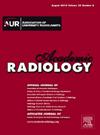利用一站式 CT 扫描进行深度学习,预测接受再灌注治疗的脑卒中患者的出血转化:一项多中心研究。
IF 3.8
2区 医学
Q1 RADIOLOGY, NUCLEAR MEDICINE & MEDICAL IMAGING
引用次数: 0
摘要
理由和目标:出血性转化(HT)是急性缺血性卒中(AIS)患者再灌注治疗后最严重的并发症之一。本研究旨在利用多相计算机断层扫描血管造影(CTA)和计算机断层扫描灌注(CTP)图像开发和验证深度学习(DL)模型,以实现对出血性转化的全自动预测:在这项多中心回顾性研究中,共回顾了 229 例在 2019 年 6 月至 2022 年 5 月期间接受再灌注治疗的 AIS 患者。数据集 1 包括来自两家医院的 183 名患者,用于训练、调整和内部验证。数据集 2 包括来自第三家医院的 46 名患者,用于外部测试。对 DL 模型进行了训练,以便从多相 CTA 和 CTP 图像中提取有价值的信息。DenseNet 架构用于构建 DL 模型。我们开发了单相、单参数模型和组合模型来预测 HT。我们使用接收者操作特征曲线对模型进行了评估:229名患者(平均年龄66.9岁±10.3岁;男性144人[66.9%])中有69人(30.1%)出现高血压。在单相模型中,动静脉相模型的性能最高。在单参数模型中,时间-峰值模型更胜一筹。在考虑组合模型时,CTA-CTP 模型的预测准确性最高:结论:基于多相 CTA 和 CTP 图像预测 HT 的 DL 模型可以建立,并且性能良好,为临床医生做出治疗决策提供了可靠的工具。本文章由计算机程序翻译,如有差异,请以英文原文为准。
Deep Learning Using One-stop-shop CT Scan to Predict Hemorrhagic Transformation in Stroke Patients Undergoing Reperfusion Therapy: A Multicenter Study
Rationale and Objectives
Hemorrhagic transformation (HT) is one of the most serious complications in patients with acute ischemic stroke (AIS) following reperfusion therapy. The purpose of this study is to develop and validate deep learning (DL) models utilizing multiphase computed tomography angiography (CTA) and computed tomography perfusion (CTP) images for the fully automated prediction of HT.
Materials and Methods
In this multicenter retrospective study, a total of 229 AIS patients who underwent reperfusion therapy from June 2019 to May 2022 were reviewed. Data set 1, comprising 183 patients from two hospitals, was utilized for training, tuning, and internal validation. Data set 2, consisting of 46 patients from a third hospital, was employed for external testing. DL models were trained to extract valuable information from multiphase CTA and CTP images. The DenseNet architecture was used to construct the DL models. We developed single-phase, single-parameter models, and combined models to predict HT. The models were evaluated using receiver operating characteristic curves.
Results
Sixty-nine (30.1%) of 229 patients (mean age, 66.9 years ± 10.3; male, 144 [66.9%]) developed HT. Among the single-phase models, the arteriovenous phase model demonstrated the highest performance. For single-parameter models, the time-to-peak model was superior. When considering combined models, the CTA-CTP model provided the highest predictive accuracy.
Conclusions
DL models for predicting HT based on multiphase CTA and CTP images can be established and performed well, providing a reliable tool for clinicians to make treatment decisions.
求助全文
通过发布文献求助,成功后即可免费获取论文全文。
去求助
来源期刊

Academic Radiology
医学-核医学
CiteScore
7.60
自引率
10.40%
发文量
432
审稿时长
18 days
期刊介绍:
Academic Radiology publishes original reports of clinical and laboratory investigations in diagnostic imaging, the diagnostic use of radioactive isotopes, computed tomography, positron emission tomography, magnetic resonance imaging, ultrasound, digital subtraction angiography, image-guided interventions and related techniques. It also includes brief technical reports describing original observations, techniques, and instrumental developments; state-of-the-art reports on clinical issues, new technology and other topics of current medical importance; meta-analyses; scientific studies and opinions on radiologic education; and letters to the Editor.
 求助内容:
求助内容: 应助结果提醒方式:
应助结果提醒方式:


